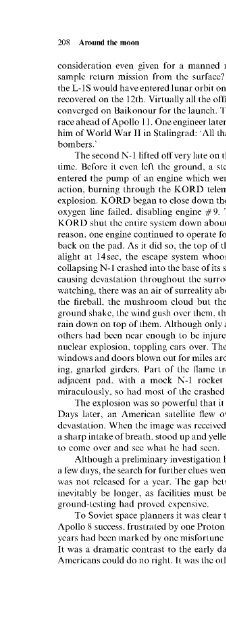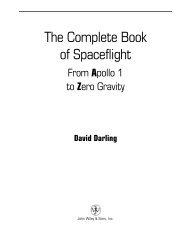Soviet and Russian Lunar Exploration
Soviet and Russian Lunar Exploration
Soviet and Russian Lunar Exploration
You also want an ePaper? Increase the reach of your titles
YUMPU automatically turns print PDFs into web optimized ePapers that Google loves.
consideration even given for a manned mission to lunar orbit to accompany the<br />
sample return mission from the surface? Assuming the same profile as February,<br />
the L-1S would have entered lunar orbit on 7th July, left for Earth on the 9th <strong>and</strong> been<br />
recovered on the 12th. Virtually all the officials concerned with the space programme<br />
converged on Baikonour for the launch. This was a heroic effort to stay in the moon<br />
race ahead of Apollo 11. One engineer later recounted that the frantic scenes reminded<br />
him of World War II in Stalingrad: 'All that was missing was the German Stuka dive<br />
bombers.'<br />
The second N-1 lifted off very late on the night of 3rd July, at 11: 18 p.m. Moscow<br />
time. Before it even left the ground, a steel diaphragm from a pulse sensor broke,<br />
entered the pump of an engine which went on fire, putting adjacent engines out of<br />
action, burning through the KORD telemetry systems <strong>and</strong> setting the scene for an<br />
explosion. KORD began to close down the affected engines: 7, 8, 19 <strong>and</strong> 20. Then an<br />
oxygen line failed, disabling engine #9. The cabling system once again disrupted,<br />
KORD shut the entire system down about 10 sec into the mission (though, for some<br />
reason, one engine continued to operate for as long as 23 sec). The N-1 began to sink<br />
back on the pad. As it did so, the top of the rocket, now 200 m above the pad, came<br />
alight at 14 sec, the escape system whooshing the L-1S cabin free just before the<br />
collapsing N-1 crashed into the base of its st<strong>and</strong>, utterly destroying the launchpad <strong>and</strong><br />
causing devastation throughout the surrounding area. For the thous<strong>and</strong>s of people<br />
watching, there was an air of surreality about it. They saw the rocket topple <strong>and</strong> fall,<br />
the fireball, the mushroom cloud but they didn't hear a thing. Then they felt the<br />
ground shake, the wind gush over them, the thunderous deafening roar <strong>and</strong> the metal<br />
rain down on top of them. Although only a few had sheltered in bunkers, none of the<br />
others had been near enough to be injured. The explosion had the force of a small<br />
nuclear explosion, toppling cars over. The physical destruction was enormous, with<br />
windows <strong>and</strong> doors blown out for miles around <strong>and</strong> little left of the pad but smouldering,<br />
gnarled girders. Part of the flame trench had even collapsed. Amazingly, the<br />
adjacent pad, with a mock N-1 rocket still installed, had survived. Even more<br />
miraculously, so had most of the crashed N-1's own tower.<br />
The explosion was so powerful that it triggered seismographs all over the world.<br />
Days later, an American satellite flew overhead, snapping the scorch marks <strong>and</strong><br />
devastation. When the image was received by an analyst in Washington DC he took<br />
a sharp intake of breath, stood up <strong>and</strong> yelled at the top of his voice to all his colleagues<br />
to come over <strong>and</strong> see what he had seen.<br />
Although a preliminary investigation had guessed the cause of the disaster within<br />
a few days, the search for further clues went on for some time <strong>and</strong> the definitive report<br />
was not released for a year. The gap between this launch <strong>and</strong> the next one would<br />
inevitably be longer, as facilities must be rebuilt. Again, the failure to go for full<br />
ground-testing had proved expensive.<br />
To <strong>Soviet</strong> space planners it was clear that the game was nearly up. Foiled by the<br />
Apollo 8 success, frustrated by one Proton <strong>and</strong> N-1 failure after another, the past two<br />
years had been marked by one misfortune after another. Nothing seemed to go right.<br />
It was a dramatic contrast to the early days when they could do no wrong <strong>and</strong> the<br />
Americans could do no right. It was the other way round now <strong>and</strong> Apollo steamed on







